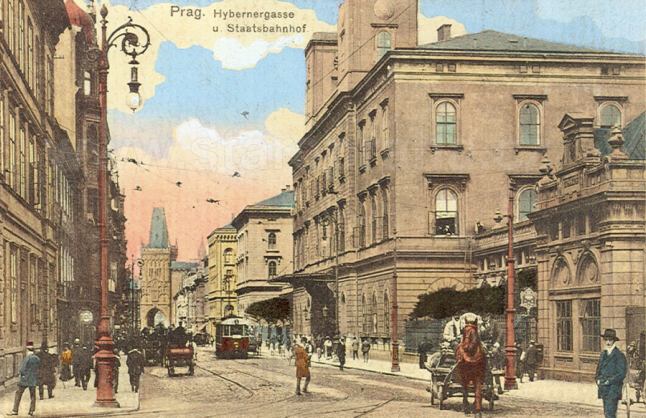
PhDr. KATEŘINA BEČKOVÁ: HYBERNSKÁ STREET
Hybernská did not come into existence at the time of the development of the principal street network in 1348, but some 30 years later, probably in connection with the evolution of Charles courtyard - the Old Town residence of Wenceslas IV, the site of which is occupied by the art nouveau Municipal House today. The direction of the street was precisely identical to an east-west parallel and it established a fluent link to Celetná Street. The lots for its buildings were extensive and broad. The importance of this streeet as a thoroughfare is also evidenced by its imposing architecture, a few mansions having survived until the present day.
In the middle ages Hybernská Street was referred to as Dlážděná (=paved) or Horská (=mountain) Street. The first denomination reveals that it was one of the few streets of mediaeval Prague to be paved, the second that it was from this street that the way to the town of Kutná Hora led. One of the historic names of the street was that of Svatoambrožská (=of St Ambrose) because of the monastery of the Ambrosians which was founded by Charles IV in 1355. It ceased to exist as early as during the Hussite Wars and before the mid-17th century Franciscans from Ireland settled here. In Bohemia they were referred to as Hibernians because of the country of their origin (Ireland in Latin is Hibernia). The Franciscans constructed a new building pertaining to the monastery and a church, which was disestablished in 1786 by Josef II as part of his rationalisation reforms. The buildings and the church were reconstructed in Neo-Classical style in the first half of the 19th century to serve as offices and a customs’ office.
The train station of the state railway (today Masaryk railway station) is typical of Hybernská Street in the 1840s. The station was constructed between 1844 and 1845 in the densely built-up site between Hybernská and Jezdecká Streets (the present name of the latter is Havlíčkova). During its construction a section of the city fortification which demarcated Prague at that time was damaged. On August 20, 1845 the burghers of Prague solemnly welcomed the first train.
